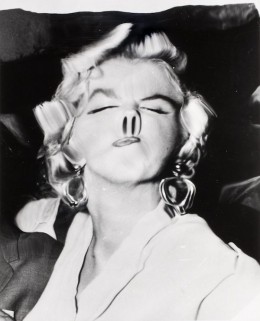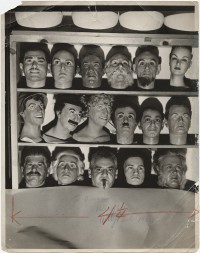MOCA REVIEW: Weegee gets his turn in the spotlight

LOS ANGELES — The Museum of Contemporary Art’s new exhibit on the prolific photographer known as Weegee is salaciously entertaining, almost like picking up a tabloid magazine and learning who’s pregnant, who’s got bags under her eyes, who’s sleeping around, who’s on the brink of divorce. Weegee is largely credited as one of the first professionals with an undying fascination with all things celebrity. His work, more than most of his contemporaries, resonates with a 2012 audience that can’t get enough of the gossiping grapevine.
MOCA’s exhibition, which runs through Feb. 27 and is the first time Weegee’s work has been collected, attempts to find the art behind what appears at first glance to be artless photographs. The museum succeeds in finding the subtext to Weegee’s work, focusing not just on the famous portraits, but also the quieter, often moving pieces about the hoopla that surrounds a movie premiere or star sighting.
Weegee’s best work has no identifiable faces. For as much as he tried to become the cameraman for the posh crowd of southern California, it’s in these simpler shots that he finds his most careful lens.
In “Hollywood Premiere,” the photographer captures wide-eyed children jabbing their fingers at the passing celebrities and extending their little autograph books high into the air. There is no Elizabeth Taylor or Marilyn Monroe in sight, just the children and their looks of expectant joy.
In “The Gold Painted Stripper,” one of the most revealing photos in the collection and also one of Weegee’s finest, an exotic dancer sips a glass of water, perhaps just finishing her routine. Her naked torso stretches the length of the picture, and she seems to be beauty personified — a woman with the looks and independence of someone from a later age, certainly not 1950. Be sure to catch the men in the background shying away from the camera, no doubt embarrassed to be caught on film in the back room of a strip club.
Weegee always played with this “other” side of the entertainment industry. Capturing an image of a bosomy starlet with a mink scarf is for the dime-a-dozen crowd. He was more interested in the hidden shots that often went unreported in Hollywood. In many ways, he broke down the image of celebrity and poked fun at the construct of fame.
The photographer was not a person who shuddered in the shadows, hoping to let his work shine through to the audience. Weegee was a bona fide celebrity among celebrities. He acted bit parts in Hollywood films, and his photography book of crime scenes from New York City was made into a successful movie (Naked City). Many of the photographs at MOCA are of the artist himself, either shaking hands with an actor or posing in a ridiculous manner.
His most iconic shots are probably his celebrity portraits, many of which Weegee distorted and combined with other photos. His Marilyn Monroe photo looks like a pig more than the famous blonde bombshell. His Elizabeth Taylor picture is not of the gorgeous actress posing on a red carpet, but of her eating, with a large spoonful of food in her mouth.
Thankfully, MOCA retains many of the originals, displaying them next to their morphed cousins.
Other objects on display include what modern-day audiences would call “Photoshopped” art. The best of the bunch is one of Vampira, the famous horror hostess, appearing in a white swimming suit within a bottle of Chanel No. 5. It looks like a 2012 commercial for the famous perfume.

Each of the photographs at MOCA are presented as objects for inspection, rather than simply artistic endeavors. There are no elaborate frames, and many of Weegee’s notes can be read on the borders of each picture. This rawness is appreciated, letting us look even closer at the process of how this seemingly strange man was able to document an era of glitz, glamour and guffaws.
By John Soltes / Publisher / John@HollywoodSoapbox.com
- Naked Hollywood: Weegee in Los Angeles is currently running at the Museum of Contemporary Art’s Grand Avenue branch. The museum is located at 250 South Grand Ave. in Los Angeles. The exhibit, which is part of the larger Pacific Standard Time initiative, runs through Feb. 27.
- Click here for more information.

